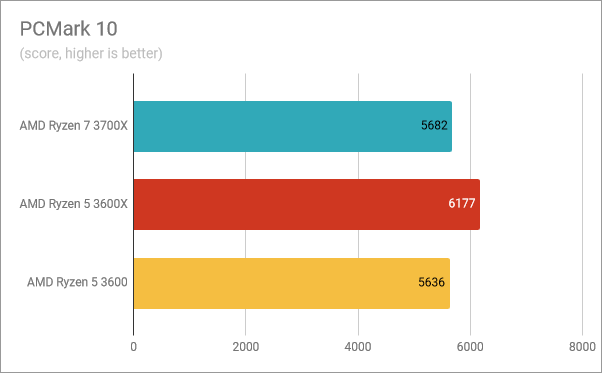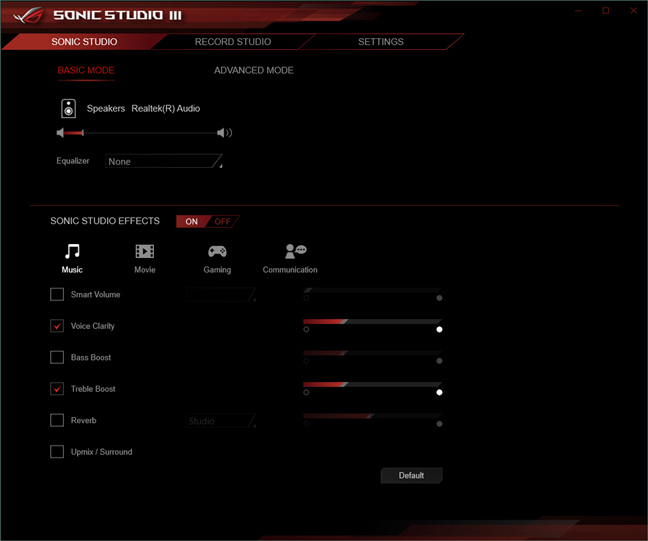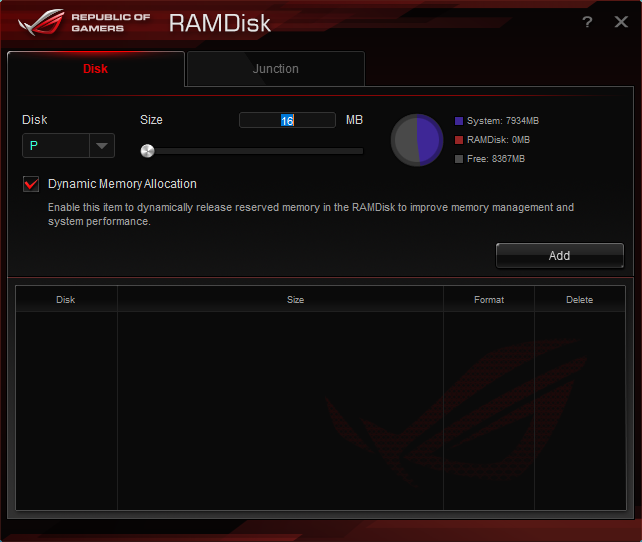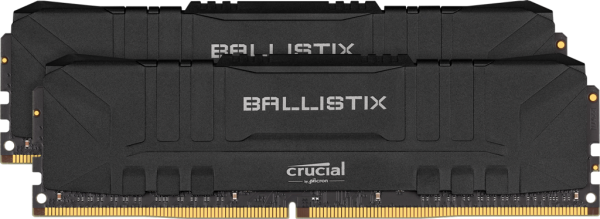
ASUS ROG Crosshair VIII Hero (Wi-Fi) - Benchmark results
We tested ASUS ROG Crosshair VIII Hero (Wi-Fi) motherboard together with the following hardware and software:
- Processor: AMD Ryzen 7 3700X, AMD Ryzen 5 3600X, and AMD Ryzen 5 3600
- Memory: HyperX Predator DDR4 RGB Memory (2 x 8GB, 3600MHz)
- Graphics Card: ASUS ROG STRIX GTX 1660 Ti GAMING OC
- Storage: ADATA XPG Gammix S11 Pro SSD
- Monitor: ASUS ROG Strix XG32VQ Curved Gaming Monitor (32-inch WQHD 2560 x 1440, 144Hz)
- Power Supply Unit: ASUS ROG Thor 850W Platinum
- Operating System: Windows 10 Pro x64 with May 2019 Update
We started by running the benchmark offered by CPU-Z. In the Single Thread test, using the same ASUS ROG Crosshair VIII Hero (Wi-Fi) motherboard, the Ryzen 7 3700X processor scored 515 points, Ryzen 5 3600X got 502 points, and Ryzen 5 3600 scored 470 points.
In CPU-Z's Multi Thread test, which measures the multi-core performance of the processor, Ryzen 7 3700X got 5428 points, Ryzen 5 3600X scored 4018 points, and Ryzen 5 3600 got a score of 3658.
Then we ran Cinebench R20, a benchmark that measures the computer's rendering speed. With AMD's Ryzen 7 3700X we got 4672 points, with AMD Ryzen 5 3600X 3521 points, and together with AMD Ryzen 5 3600, we measured 3221 points.
In Blender, which measures the time needed by the computer to render two different scenes, the 3700X CPU finished in 17.25 minutes, the 3600X in 22.17 minutes, and the Ryzen 5 3600 in 22.85 minutes.
Next, we ran PCMark 10, a benchmark that aims to measure the computer's performance in regular activities such as web browsing, video conferencing, app start-up times, productivity, and digital content creation. Using the same ASUS ROG Crosshair VIII Hero (Wi-Fi) motherboard, we got 5682 points with Ryzen 7 3700X, 6177 with Ryzen 5 3600X, and 5636 with Ryzen 5 3600.
Web browsing is one of the most common activities for anyone using a computer. That's why the speed at which your web browser can render websites is essential. To measure the performance of our computer using the ASUS ROG Crosshair VIII Hero (Wi-Fi) motherboard, when surfing on the internet, we used JetStream 2, which uses JavaScript and WebAssembly. We saw excellent results regardless of the processor mounted on the motherboard: 148 points Ryzen 7 3700X, 139 for the Ryzen 5 3600X, and 136 points for the Ryzen 5 3600 CPU.
We also tested a few games, starting with Shadow of the Tomb Raider. Its benchmark tool showed that all the processors we had could render more than 200 frames per second. These results are valid when using 1080p resolution and the lowest graphics quality, and show only what the processors can deliver - in the real world, the number of frames per second is greatly diminished by the performance of the video card that you have.
In Metro Exodus, which has demanding hardware requirements, both in terms of video and processor performance, we measured an average frame rate of more than 100. Again, we got these results using 1080p and low quality for graphics details.
In World War Z, using the Vulkan API, a resolution of 1080p, and the lowest graphics quality, we measured an average frame rate of 195 when using the AMD Ryzen 5 3600, and 209 fps when using the 3700X and the 3600X.
Benchmarking a motherboard is not useful outside the area of statistics because it all depends too much on other things like what processor, RAM, or storage you use. However, if you take a look at our findings, you know that the ASUS ROG Crosshair VIII Hero (Wi-Fi) delivers excellent results regardless of what AMD processor you're using with it.
The software bundled with ASUS ROG Crosshair VIII Hero (Wi-Fi)
Despite ASUS' history of offering fragmented apps that never seemed to work as they should have, our experience has been good with this motherboard. ASUS still offers many different apps, but some essential parts (settings and features) have been mixed together and are available via a new app called Armoury Crate. After you install Windows 10, you are immediately invited to install it, and we recommend that you do so. However, it's a UWP app available in the Microsoft Store, so you can also install it later on, if you prefer. Its reviews from the Store are not great, but our experience with it has been quite positive, even if it's in a Beta stage.
What does Armoury Crate do and why do we recommend it? Well, Armoury Crate is a sort of hub that lets you install the motherboard drivers automatically and all at once, choose what additional utility apps you want, update BIOS, control the Aura Sync RGB lighting effects, adjust settings for some of your other Republic of Gamers devices, and also save your settings in the cloud using your ASUS user account.
When it comes to AURA Sync, the app also feels like a great improvement compared to the older AURA Lighting Control program, that was filled with bugs: on most of our previous computers, it worked only when it wanted to and only managed to frustrate us.
The other automatically installed apps are Sonic Studio III and Sonic Radar III, which are two apps required for adjusting and configuring the audio chipset. They include plenty of customization options both for playback and for recording, so you're probably going to like them.
The optional utility apps that ASUS offers for the ASUS ROG Crosshair VIII Hero (Wi-Fi) motherboard include some useful tools, but also some apps that you might not want. Here's the full list:
- Google Chrome: the most widely used web browser in the world, so no further explanations are required.
- AI Suite 3: a desktop program that analyzes your system and shows you information about it, as well as helps you optimize things such as power consumption or the speed of the fans.
- BullGuard Internet Security: a security solution that includes a good antivirus and firewall, and for which, in theory, you get a one-year subscription. However, when we installed it, we only got a few weeks trial.
- CPUID ROG CPU-Z: a small tool that shows you information about your processor and also lets you quickly benchmark it.
- GameFirst V: a tool made by ASUS that helps you optimize the network traffic in order to have a lag-free gaming experience.
- Overwolf: a platform that lets you display an overlay while gaming with information from various apps available in the Overwolf Appstore. For example, you can get statistics and details about your companions and opponents in League of Legends.
- RAM Cache III: creates a fast cache in your system's RAM to help speed up games loading.
- ROG RAMDisk: lets you create a virtual disk using some of your RAM. Obviously that virtual disk is fast, but it also means that you must lock part of your RAM for that sole purpose, so, unless you have a lot of RAM in your PC, you might not gain much from using RAMDisk.
- WinRAR: a popular shareware compression tool.
We found the essential software and apps available for ASUS ROG Crosshair VIII Hero (Wi-Fi) to be better than what we've seen in the past from ASUS. The Armoury Crate app, although still in beta stage, worked well on our computer. As for the additional apps offered, regardless of whether you find them useful or not, you can choose on your own whether to install them or not.
What's your opinion about the ASUS ROG Crosshair VIII Hero (Wi-Fi)?
At the end of this review, it is obvious that we like the ASUS ROG Crosshair VIII Hero (Wi-Fi) motherboard a lot. Before closing, tell us your opinion about it. Do you own it or do you intend to buy it in the near future? Comment below and let's discuss this motherboard.


 03.10.2019
03.10.2019 
















